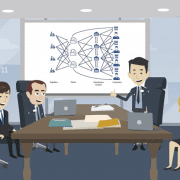Supply Chain and Procurement Transformation in 2021
Some say COVID-19 is changing the future of supply chain. It’s not.
The pandemic has only reinforced what we already knew, what Bristlecone and other industry thought leaders have long been evangelizing: If not built to withstand disruption – or better yet, to leverage it – the supply chain can, and will, crumble under stressors like demand volatility.
Our research indicates that COVID-19 impacted 98% of businesses, with 60% reporting an ‘extreme’ impact. Unfortunately, that means 98% of businesses learned a difficult lesson last year. And when compared to overall business impact, executives say their supply chain was more susceptible to disruption from COVID-19 than their workforce, systems or operations.
Disruption dominated the headlines in 2020, but it’s a common story and a constant threat.
According to a pre-COVID report published by the Federal Emergency Management Agency (FEMA), 40% of businesses do not reopen following a natural disaster. On top of that, another 25% fail within one year. And it’s not just natural disasters causing disruption. Political unrest, industry regulations, terrorism and other incidents can instantly derail a supply chain. Today, despite COVID-19 slowing maritime traffic, piracy is thriving off the coast of West Africa and two of the shipping industry’s key players suffered cyberattacks just ahead of their peak season.
Most supply chains simply weren’t built to handle disruption on any scale.
With the global supply chain becoming as much a dining room discussion as it has a boardroom discussion, COVID-19 has served to amplify and accelerate the need for supply chain resiliency. It has been a wakeup call for the C-suite, bringing with it a sense of responsibility and urgency.
So, while COVID-19 may not be changing the future of supply chain, it certainly helped make the case for digital transformation – which is great news for supply chain and procurement professionals who have been trying to persuade the top brass to embrace change.
What supply chain trends will we see this year?
Many business leaders are ushering in the new year with optimism and enthusiasm – and when it comes to supply chain transformation, the year is full of promise and possibility.
This year, we’ll see continued focus on building resiliency into supply chain and procurement functions. (Check out these five tips to build supply chain resiliency.) Many pre-COVID trends are now carrying over into 2021, not only because they help build supply chain resiliency, but also because they’re good business practices.
- Navigating Demand Volatility. Even before COVID, demand volatility was an area of concern. Our research indicates that only 34% of businesses have an active supply chain risk management program. We will likely continue to see demand volatility well into 2021, putting an increased focus on supply chain visibility and risk management.
- Enhancing Supplier Relationships. Businesses are starting to involve suppliers in activities prior to procurement and getting to know them better. They’re also building alternate supplier bases and designing balanced decoupling strategies. Some are now replacing emails and spreadsheets with powerful real-time supplier collaboration tools.
- Delivering Value. Driving savings will always be a primary goal of procurement, but it’s increasingly understood that procurement organizations can deliver great value that goes way beyond cost savings, cost containment and cost avoidance. AI-powered supply chain automation, better use of data and new analytics technologies also add value.
- Managing Change. Business leaders are beginning to realize that people are key to digital transformation success. Technology changes quickly; companies do not. Involving stakeholders in end-to-end process reviews and benchmarking, while establishing a high-touch change management program early-on, can help build a culture of change.
How does digital transformation benefit procurement?
Digital transformation is about leveraging technologies to create or modify business processes, corporate culture and customer experience in ways that deliver value. In procurement, saving on labor costs, accelerating processes, enhancing supplier relationships, improving cashflow management and achieving end-to-end visibility are all digital transformation drivers.
Let’s look at some digital transformation benefits in three specific areas of procurement.
- Strategic Sourcing becomes more predictive by improving visibility into spend, driving informed decision-making, providing a deeper understanding of sourcing costs across suppliers, simplifying supplier selection, and reducing overall cycle time.
- Procure-to-Pay achieves automation by streamlining processes, eliminating repetitive tasks, requiring only minimal human intervention to address incongruities, automatically detecting depletion of goods and triggering purchases, and automating payments.
- Supplier Management becomes seamless and proactive by providing a single platform for supplier onboarding, qualification and performance, reducing risk through improved data analysis and preemptive risk mitigation, and strengthening supplier relationships.
Where do we start?
We’ve already established that the business case for digital transformation should be an easier sell, thanks in large part to COVID-19. The next steps are to gain visibility into your procurement function, identify and understand gaps and opportunities, and align data, processes, systems and people in a detailed roadmap that will guide your digital transformation journey.
Procurement Diagnostics provide an effective way to get to the roadmapping stage quickly, and armed with insights. Diagnostics offer an impartial opportunity to evaluate your procurement function, while also enabling you to see how you stack up against industry best practices.
The most important thing to remember is that digital transformation is a journey – and while the journey is different for each organization, every journey must begin with a single step.
Ready to take a step in the right direction? Let’s schedule a time to chat.







